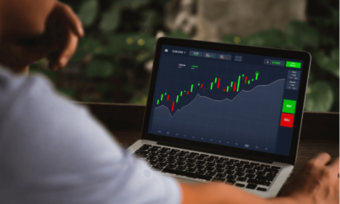Fractional share investing: what you need to know

If you want to invest in a company, you don’t need to buy a full share. There are ways you can invest in a share of a share, known as a fractional share. So how does it work?
When you invest in shares you are effectively buying into a share of a company listed on a sharemarket. The hope is that the share price will go up and you may be able to tap into a share of any profits that company pays in dividends.
Some shares are relatively cheap that you can buy for just a few cents each, while others can be expensive and cost several hundred dollars each to buy. Some overseas share prices can be in the tens of thousands of dollars, just for one share.
But you are usually limited to a minimum purchase if you want to buy shares in a particular company. This is typically about $500 for a company listed on the Australian Securities Exchange (ASX), known as the minimum marketable parcel.
Read more: What is a share?
That could put some people off, especially as a first-time investor. Or you may wish to invest in one of the very expensive shares overseas but can’t afford to buy even a single share.
So should you consider buying a fraction of a share instead?
What is a fractional share?
A fractional share is exactly that: it’s a part of a share in an investment. For example, if a company’s share price is $100 and you only have $25, then you can buy just a quarter (25%) of a single share for $25. Other fees and charges may apply.
There are a few platforms that allow you to buy a fractional share in a company or managed fund here in Australia or overseas.
For example, the share trading platform Sharesies says you can invest as little as 1c in a fractional share of a company or exchange-traded fund (ETF) listed on the Australian, New Zealand or the United States sharemarkets.
In practice you’d probably be looking to invest more than that but the point made by the trading platform is that you can buy a fractional share in a company, below the $500 minimum required by the ASX.
Some other platforms that offer fractional trading options include Raiz, Stake, Interactive Brokers and eToro.
Raiz’s Chief Investment Officer, Grant Brits, told Canstar its platform lets you invest from $5 or more at a time in set portfolios it holds that vary in risk levels from conservative to more aggressive.
“If you like to take a risk you can start very small,” he said.
“You don’t need to commit a large amount of money.”
Whatever platform you use to buy into fractional shares, factor in any upfront and ongoing fees and charges when making an investment, and read the terms and conditions. Check also to see if any relevant Product Disclosure Statements (PDS) and Target Market Determination (TMD) documents may apply.
Who owns the fractional share?
Typically when you buy shares in a company you become the registered owner of those shares. That’s not always the case with fractional shares, said Dr Campbell Heggen, a Senior Lecturer in Financial Planning at Deakin University.
“When you initiate a trade for a fraction of a share, the broker buys the whole share and makes an entry in your brokerage account reflecting the value of your ownership,” he told Canstar.
For example, he said if you invest your $25 dollars in a company with a current share price of $100, your brokerage account will show that you own a 0.25 share of that company. The broker retains ownership of the other 0.75, which it can use to distribute out to other fractional investors.
The key thing here is that you don’t personally own that fraction of a share in your name.
“Your fractional ownership is typically facilitated through a custody arrangement, where the broker is the registered owner of the whole share and you, the investor, are the ‘beneficial owner’ – meaning your money and investments are held on trust for you by the legal owner,” Dr Heggen told Canstar.
That’s the case with Sharesies, which says any investment you buy via its platform is held by the New Zealand registered company, Sharesies Nominee Limited. You’re still entitled to the economic value and other benefits attached to your shares.
That type or arrangement is typical for fractional shares, said Dr Heggen, but it can have its downsides.
“As you are not the legal owner of the shares, you might not be able to transfer them to a different broker or into your name if you wish to do so at a later date,” he said.
“This may mean you would need to sell the shares and repurchase them if you wanted to change brokers, which would likely have tax implications.”
Is it a good idea to buy fractional shares?
Whether it’s a good idea to buy fractional shares depends on factors such as your circumstances, what you can afford and the risks you are prepared to take.
Dr Tracey West, an expert in finance at Griffith University, said investing in fractional shares comes with the same potential risks and benefits of owning any shareholding, no matter the size. A share price may rise or fall, for example, and it may pay a dividend or it may not.
“The ability to invest a small amount makes it accessible,” she told Canstar, “but the platform needs to recoup costs, so it will do that through fees, sponsorship, advertising, selling data, so how does that balance out for the client?”
Read more: The pros and cons of buying shares
Again, that’s why it’s important to check the fees and charges and read the fine print, irrespective of your choice in investment platform.
Dr Heggen said any ongoing regular fees or charges could quickly eat away at your account, especially if you only have a small amount to invest in a fractional share portfolio.
Judith Fox, Chief Executive Officer of the Stockbrokers and Financial Advisers Association, also urged caution on costs when using these platforms, especially with currency conversion fees.
That said, she said fractional investing was a good way for people to start investing and tap into some of the more expensive stocks, such as Google and Amazon.
“The interest in the new trading platforms indicates that getting involved in share investing, either fractional or otherwise, can help to build familiarity and confidence,” she told Canstar.
With any investments, keep in mind past performance is not a reliable indicator of future performance.
Can I get rich from fractional shares?
You may make money if the share price goes up but given you are investing in a fractional share you will only benefit from a fractional proportion of any price rise.
Consider this hypothetical scenario: You paid $25 for a 25% fractional share that was valued at $100 full price and say the share increased to $110. If you decided to sell, you would only get a 25% of that $10 increase, which would be $2.50, excluding any fees or charges you may also have to pay.
The same applies to any dividend a company pays out. You only get a fractional amount based on your fractional ownership.
But there’s always the risk that you could lose some or all of your money too, including through fees and charges related to your fractional share investments.
Is there a downside to buying fractional shares?
Many of the risks associated with buying a fractional share are the same as if you bought a full share. Share prices can go up and down and no one can tell you which way they will go on any given day. Markets can also crash.
Read more: 4 stock market crashes and what caused them
But if you want to learn more about trading on the sharemarket, fractional share investing could offer you a low cost way of starting your investment portfolio and improving your financial literacy.
Dr Heggen said fractional investing could also actually make diversification in your investments possible at a lower cost than traditional full-price share investing.
“Since you don’t need as much money to invest, it makes it more affordable to spread your money across a number or separate shares/companies,lowering your overall risk,” he said.
“For example, instead of investing $25 in a single company, you could instead invest $5 each in five different companies.”
Remember too though that with lower risk, you may also get lower profits due to your fractional ownership, and not all of the investments may be profitable.
Compare online trading platforms
Cover image source: Tijana Simic/Shutterstock.com
This article was reviewed by our Sub Editor Jacqueline Belesky before it was updated, as part of our fact-checking process.

Michael is an award-winning journalist with more than three decades of experience. As a senior finance journalist at Canstar, Michael wrote more than 100 articles covering superannuation, savings, wealth, life insurance and home loans. His work's been referenced by a number of other finance publications, including Yahoo Finance and The Motley Fool.
Michael's worked as a reporter and producer for the BBC and ABC, including for Australian Story. He's also worked as a feature writer for The Courier-Mail and as a science and technology editor and commissioning editor at The Conversation.
Michael's professional awards include a Queensland Media Award and a highly commended in the Walkleys. In 2021 he was part of a team that was a finalist in the Australian Museum Eureka Prize for Science Journalism. He holds a Bachelor of Science in mathematics and applied physics (Manchester Metropolitan University) and a Masters of Science in pure mathematics (Liverpool University).
Try our Online Share Trading comparison tool to instantly compare Canstar expert rated options.





